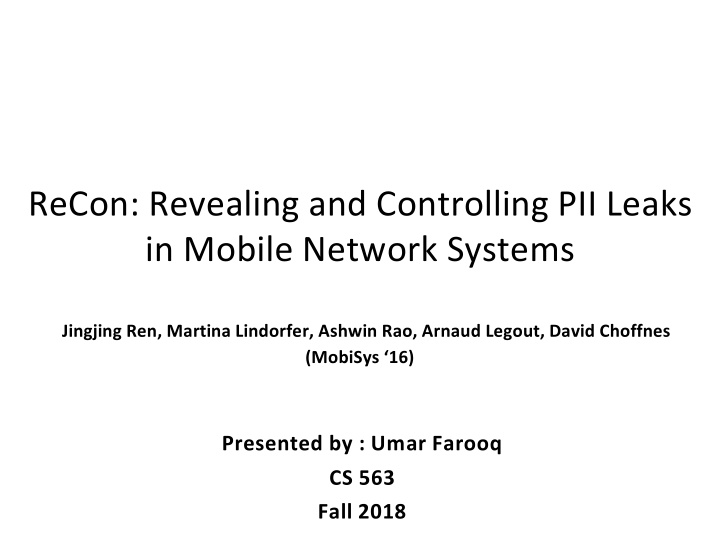



ReCon: Revealing and Controlling PII Leaks in Mobile Network Systems Jingjing Ren, Martina Lindorfer, Ashwin Rao, Arnaud Legout, David Choffnes (MobiSys ‘16) Presented by : Umar Farooq CS 563 Fall 2018
Mobile Phones today.. q Offer ubiquitous connectivity q Equipped with a wide array of sensors q Examples; GPS, camera, microphone etc.
Problems q Personally identifiable info. (PII) leakage § Device Identifiers (IMEI, MAC address, etc.) § User Information (name, gender, contact info, etc.) § Location (GPS, zip code) § Credentials (?) q Device Fingerprinting q Cross Platform tracking
App Store Google Play WP Store 0.6 0.5 0.4 0.3 0.2 0.1 0 User Identifier Contact Info Location Credential Device Identifier (email, name, (username, (IMEI, Advertiser gender etc.) password) ID, MAC etc.)
Goals for this work q Identify PII leakage without a priori information q Provide users a platform to view potential PII leaks (i.e increase user visibility and transparency)
Approach.. q Opportunity: Almost all devices support VPNs q Have a trusted third party system to audit network flows § Tunnel traffic to a controlled server (trusted server) § Measure, modify, shape or block - traffic with user opt in
Why should this work?
So, what does a PII look like? GET /index.html?id=12340;foo=bar;name=CS5 63@Illini;pass=jf3jNF#5h How can we identify a PII leak? Naïve approach: Pattern matching.
ReCon: A system using supervised ML to accurately identify and control PII leaks from network traffic with crowdsource reinforcement.
Automatically Identifying PII leaks q Hypothesis: PII leaks have distinguishing characteristics § Is it just simple key/value pairs (e-g “user_id=563”) • Nope, leads to high FPR (5.1%) and high FNR (18.8%). q Need to learn structure of PII leaks. q Approach: Build ML classifiers to reliably detect leaks. § Doesn’t require knowing PII in advance § Resilient to changes in PII formats over time.
Initial Training Flows Features Training Model Continuous training with user feedback Manual test: top 100 apps from each official • User Feedback store User Automatic test: top 850 Android apps from a • Flows Model Prediction Interface third party store Rewriter architecture
Initial Training Flows Features Training Model Continuous training with user feedback • Feature extraction: bag of words User Feedback User Flows Model Prediction Interface Rewriter architecture
Initial Training Flows Features Training Model Continuous training with user feedback • Feature extraction: bag of words User Feedback • Use thresholds to remove infrequent or too frequent words User Flows Model Prediction Interface Rewriter architecture
Initial Training Flows Features Training Model Continuous training with user feedback Ground truth from the controlled experiments • User Feedback C4.5 decision tree • User Per-domain and per-OS classifier • Flows Model Prediction Interface Rewriter architecture
Initial Training Flows Features Training Model Continuous training with user feedback User Feedback User Flows Model Prediction Interface Rewriter architecture
Initial Training Flows Features Training Model Continuous training with user feedback User Feedback User Flows Model Prediction Interface Rewriter architecture
Evaluation – Accuracy (CCR) DT outperforms Naïve Bayes • Time: DT based ensembles take more time than a simple DT • More than 95% accuracy per-domain-and per OS l • Greater than the General Classifier • 60% DTs zero error. •
Evaluation – Accuracy (AUC) Area under the curve (AUC) [0,1] • - Demonstrates the predictive power of the classifier Most (67%) DT-based classifiers have AUC = 1 •
Evaluation – Accuracy (FNR and FPR) Most DT based classifiers have zero FPs (71.4%) and FNs (76.2%)
Evaluation – Comparison with IFA q Information flow analysis (IFA) § Resilient to encrypted / obfuscated flow • Dynamic IFA: Andrubis • Static IFA: Flowdroid • Hybrid IFA: AppAudit Information flow analysis (IFA) q Susceptible to false positives, but not false negatives
ReCon vs. static and dynamic analysis 120 .0 % 100 .0 % 80 .0 % Fl ow Droi d(Sta tic IF A) An dru bi s (Dyn a mic I FA) 60 .0 % Ap pA ud it(Hy brid I FA) Re Co n 40 .0 % 20 .0 % 0. 0% De v ic e I de n tif ier Us er Id en tif ie r Co n ta c t I nf o L oc a t i on
Initial Training Flows Features Training Model Continuous training with user feedback User Feedback User Flows Model Prediction Interface Rewriter architecture
ReCon: q The retraining phase is important § FP decreased by 92% § FN increased by 0.5%
ReCon in the wild q 239 users in March 2016 (IRB approved) q 137 iOS, 108 Android devices q 14,101 PII found and 6,747 confirmed by users q 21 apps exposing passwords in plaintext § Used by millions (Match, Epocrates) § Responsibly disclosed
Discussion q Challenges § Encrypted Traffic (totally reliant on plaintext traffic) § 10-fold cross validation, does it help? • 2.2% FP and 3.5% FN, but what about overfitting? • Network flows too diverse, is the model generalizable? § Can miss out on PII leaks (FN) if model not trained for that class of PII. Standard program analysis susceptible to false positives, but not false negatives
Discussion - continued q Can we use this approach for IoT devices? § Device Identification? § PII leakage? § Monitor if IoT devices “talk” to themselves?
Questions?
Recommend
More recommend